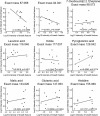Breath and Blood Metabolomics: A Comparative Study Using SESI-HRMS/MS and UHPLC-ESI-HRMS/MS
- PMID: 40567267
- PMCID: PMC12186209
- DOI: 10.1021/envhealth.4c00248
Breath and Blood Metabolomics: A Comparative Study Using SESI-HRMS/MS and UHPLC-ESI-HRMS/MS
Abstract
Breath metabolomics enables noninvasive and rapid acquisition of metabolic information by detecting volatile organic compounds (VOCs) in exhaled breath. Secondary electrospray ionization high-resolution tandem mass spectrometry (SESI-HRMS/MS) offers the highest coverage for detecting breath metabolites among current real-time breath analysis techniques. Although it has been generally recognized that metabolites in breath originate from the blood, a molecular-level understanding of the characteristics of metabolites in both breath and blood remains insufficient. In this study, nontargeted analyses of breath and blood samples from 11 healthy volunteers were performed using SESI-HRMS/MS and ultrahigh performance liquid chromatography electrospray ionization high-resolution tandem mass spectrometry (UHPLC-ESI-HRMS/MS), respectively. Tandem mass spectrometry was employed for metabolite annotation. Twenty-six breath-unique metabolites and 73 blood-unique metabolites were identified. Besides, seven metabolites were found in both breath and blood, including 7-oxabicyclo [2.2.1] heptane, levulinic acid, indole, pyroglutamic acid, malic acid, glutamic acid, and histidine. Intriguingly, the correlation of these metabolites between breath and blood was low (r < 0.4 or p > 0.05). Among all the confirmed metabolites, breath metabolites exhibit higher volatility according to their water-gas partition coefficient (log P w/g) compared to blood metabolites. In addition, gender-derived differences in breath were significantly smaller than blood. In summary, this study indicates that breath metabolites are likely to offer complementary information on blood metabolites. When combined with blood metabolomics, this would be advantageous for the appropriate application of breath metabolomics in life sciences, such as in biomarker discovery.
Keywords: SESI-HRMS/MS; UHPLC-ESI-HRMS/MS; blood metabolomics; breath metabolomics; metabolite identification; metabolomics comparison.
© 2025 The Authors. Co-published by Research Center for Eco-Environmental Sciences, Chinese Academy of Sciences, and American Chemical Society.
Figures






Similar articles
-
Intravenous magnesium sulphate and sotalol for prevention of atrial fibrillation after coronary artery bypass surgery: a systematic review and economic evaluation.Health Technol Assess. 2008 Jun;12(28):iii-iv, ix-95. doi: 10.3310/hta12280. Health Technol Assess. 2008. PMID: 18547499
-
Systemic pharmacological treatments for chronic plaque psoriasis: a network meta-analysis.Cochrane Database Syst Rev. 2021 Apr 19;4(4):CD011535. doi: 10.1002/14651858.CD011535.pub4. Cochrane Database Syst Rev. 2021. Update in: Cochrane Database Syst Rev. 2022 May 23;5:CD011535. doi: 10.1002/14651858.CD011535.pub5. PMID: 33871055 Free PMC article. Updated.
-
A rapid and systematic review of the clinical effectiveness and cost-effectiveness of paclitaxel, docetaxel, gemcitabine and vinorelbine in non-small-cell lung cancer.Health Technol Assess. 2001;5(32):1-195. doi: 10.3310/hta5320. Health Technol Assess. 2001. PMID: 12065068
-
Systemic pharmacological treatments for chronic plaque psoriasis: a network meta-analysis.Cochrane Database Syst Rev. 2017 Dec 22;12(12):CD011535. doi: 10.1002/14651858.CD011535.pub2. Cochrane Database Syst Rev. 2017. Update in: Cochrane Database Syst Rev. 2020 Jan 9;1:CD011535. doi: 10.1002/14651858.CD011535.pub3. PMID: 29271481 Free PMC article. Updated.
-
Home treatment for mental health problems: a systematic review.Health Technol Assess. 2001;5(15):1-139. doi: 10.3310/hta5150. Health Technol Assess. 2001. PMID: 11532236
References
-
- Nicholson J. K., Lindon J. C.. Organisms Often Respond in Complex and Unpredictable Ways to Stimuli That Cause Disease or Injury. By Measuring and Mathematically Modelling Changes in the Levels of Products of Metabolism Found in Biological Fluids and Tissues, Metabonomics Offers Fresh Insight into the Effects of Diet, Drugs and Disease. Nature. 2008;455:1054–1056. doi: 10.1038/4551054a. - DOI - PubMed
-
- Wishart D. S., Knox C., Guo A. C., Eisner R., Young N., Gautam B., Hau D. D., Psychogios N., Dong E., Bouatra S., Mandal R., Sinelnikov I., Xia J., Jia L., Cruz J. A., Lim E., Sobsey C. A., Shrivastava S., Huang P., Liu P., Fang L., Peng J., Fradette R., Cheng D., Tzur D., Clements M., Lewis A., De Souza A., Zuniga A., Dawe M., Xiong Y., Clive D., Greiner R., Nazyrova A., Shaykhutdinov R., Li L., Vogel H. J., Forsythe I.. HMDB: A Knowledgebase for the Human Metabolome. Nucleic Acids Res. 2009;37:D603–D610. doi: 10.1093/nar/gkn810. - DOI - PMC - PubMed
LinkOut - more resources
Full Text Sources
